Ukraine’s Famine as Reflected on the Pages of Dnipro, 1931–40
Dnipro (Chicago, Philadelphia, Trenton, NJ; 1921-1926, 1928-1950) was a Ukrainian-language newspaper of the Ukrainian Orthodox Church of the United States. In the period 1931-40 it was published in Philadelphia as a biweekly. Its intended primary audience was the Ukrainian immigrant community in the US, and the range of topics covered included news from Ukraine, faith, church and community events and affairs, literature, and letters from readers.
The following selection of excerpts from Dnipro gives some sense of what Ukrainians abroad knew about the 1932-33 famine in Ukraine at the time and about the larger socio-political context in which it occurred. In 1933, virtually every issue included more than one mention of the famine as well as related stories about Soviet economic and demographic policies, political purges, the war on religion and church, reversal of the Ukrainianization policy, and escapes from the Soviet Union.
In the 1930s, digests of news from Ukraine were featured on the front page of every issue, along with international news. Most of these ‘secondhand’ stories were based on reporting from Soviet newspapers, including the Kharkiv-based Kommunist or Moscow-based Komsomolskaia Pravda, with anecdotal evidence about, for example, the murder of members of village councils, protests to grain requisitioning, attacks on antireligious agitators, and the state prosecution of activists accused of being ‘negligent in grain procurement’, i.e., not hard enough on peasants. Quite a few news items about the famine were drawn from the eyewitness accounts of Western correspondents who visited the USSR that had been published in The Manchester Guardian, The New York Times, or The Times or by personalities such as Robert I. Ripley. One story mentions that the writings of Walter Duranty of The New York Times were likely shaped by Soviet censorship and that his reports about the situation in the USSR were not to be trusted. The paper published a summary of a letter from the journalist Rhea Clyman to NKVD head Yagoda in which she accuses him of the political persecution of hundreds of thousands of innocent civilians and mentions 35,000 Ukrainian peasant families branded as ‘kulaks’ and deported to distant labor camps.
A significant share of pieces are reports of rumors, anonymous eyewitness accounts, and personal letters from Ukraine sent to relatives in the US with desperate pleas for help, mainly for a few US dollars that would allow them to buy some bread and survive. A recurrent theme of the reporting based on ‘rumors’ (chutky) from Ukraine is rebellion among peasants, workers, and even the military and their dissatisfaction with government policies and food shortages, both in cities and the countryside. Such stories are often accompanied by a commentary that Ukraine is ready to secede from the Soviet Union and that the protest moods are more intense than ever before. One such story of a local DPU (secret police) squad burning down the village of Trubacheve or Turbacheve somewhere near Kyiv in reprisal for the peasant resistance to grain requisitioning is featured three times. However, no village by this name can be verified.
In the absence of information about the famine, the paper strives to find clues in unrelated news items, for example, in a speech by Postyshev in which he states that a quarter of the population or four million Ukrainians was illiterate, a figure that the editors see as possible indication of a drastic fall in Ukraine’s population. Thus, the news stories often feature interpretations and re-interpretations in view of the publisher’s own agenda. Many events are presented through the prism of whether they are beneficial to Ukraine’s eventual independence or impede it. Several references to a rumor that the Soviet government was preparing to repopulate Ukrainian territory devastated by famine by representatives of other Soviet nationalities, mostly by Russians, show concern that such a policy would result in the ‘denationalization’ of Ukraine.
Alarming appeals on the pages of Dnipro appear throughout 1933 both from the exiled Ukrainian intelligentsia to ‘the international moral public,’ and from the Ukrainian church leaders to Ukrainians abroad about their moral responsibility to Ukrainians in the Soviet Ukraine to be their voice and to mobilize attention and the resources of the West to try and save the millions of Ukrainian peasants dying of starvation.
Despite some questionable stories, overall, the editors of Dnipro strove to supply their readers with the best information available at the time about the 1932-33 famine in Ukraine and the efforts to address it. The primary value of the selection included here is that it reflects the American Ukrainian diaspora’s reception of the famine and surrounding events in Soviet Ukraine and the USSR at large. It is evident that the editorial staff and the leadership of the Ukrainian Orthodox Church in the US maintained strong emotional connection to events in Ukraine and felt a moral obligation to try to help their ‘brothers’ in ‘Great Ukraine’ (Central and Eastern Ukraine) through prayer, donations, and information campaigns. They perceived the famine as one aspect of a Bolshevik assault on Ukrainian culture, spirituality, and the Ukrainian political nation and lived in anticipation of the day when Soviet, ‘Muscovite’ rule that had been violently imposed on Ukraine from the outside and, according to their reporting, was opposed by every major Ukrainian social group, would fall. They called for unity within the diaspora and solidarity with Ukrainians under Soviet (and Polish) rule as a necessary precondition to achieving that end.
In some cases, we have chosen to provide a screenshot of an entire page from the newspaper in order to present a larger context and illustrate how reports of famine were surrounded by news about purges, executions and persecution of former Ukrainian Communist party leaders, intelligentsia members, religious representatives, and ‘petliurites’ (followers of Symon Petliura and advocated of Ukrainian independence). In 1934-40, when the famine had subsided, reports about persistent problems with the collectivized agriculture the Soviets had forcibly imposed are laced with hopes for a new wave of resistance among the Ukrainian peasants and workers and fear that another deadly famine could be pending in Ukraine.
This sampling of the coverage of the 1932-33 famine by one of the Ukrainian diaspora’s leading interwar periodicals is also informative about the moral struggles of Ukrainians abroad at the time. Despite their knowledge of the events widely viewed today as one of the twentieth century’s genocides, they lacked the agency and international recognition sufficient to wage an effective international humanitarian intervention campaign that might have had some impact on the suffering of the victims of famine in Soviet Ukraine.
Dnipro (1921-1926, 1928-1950) [Trenton Nj, Chicago IL, Philadelphia PA, Pittsburgh PA]

“ПРОТИ-БОЛЬШЕВИЦЬКИЙ РУХ НА УКРАЇНІ” (Page 7: Column 1 : Article 2) Based on reporting from the daily Kommunist, headquartered in Kharkiv. Topics include elections to the village councils in Ukraine, anecdotal evidence about a killing of a communist agitator, and intentional damage to agricultural equipment in Kharkiv oblast.
“СЕЛЯНИ ХОВАЮТЬ ЗБІЖЖЯ ПЕРЕД ВЛАДОЮ” (Page 7 : Column 1 : Article 3)

“ДОМАГАННЯ РОБІТНИКІВ ДОНЕЦЬКОГО БАСЕЙНУ НА УКРАЇНІ” (Page 7 : Column 1 : Article 2) Based on reporting from the Paris-based Borba. Reports about self-organized workers in Luhansk area demanding political reform, the decommunization of government, and an end to the prosecution of peasants. The demands were met with harsh repressions.

(PDF) Article 1
1931-12-01 : Page 1 : Column 3
“ВОГНЕМ ПАЛАЄ УКРАЇНА”
Article 2
1931-12-01 : Page 1 : Column 3
"УКРАЇНА МУСИТЬ ДАТИ"
Article 3
1931-12-01 : Page 1 : Column 4
"ЧЕРВОНИЙ ТЕРОР"

1932-01-15 : Page 1 : Column 1 : Article 4
“КОНТРТЕРОР НА УКРАЇНІ”
1932-01-15 : Page 1 : Column 4 : Article 1
"АРЕШТОВАННЯ НА РАДЯНСЬКІЙ УКРАЇНІ"
1932-01-15 : Page 1 : Column 4 : Article 4
"НАПИС НА БІЛЬШЕВИЦЬКОМУ ВАГОНІ"

1932-03-01 : Page 1 : Column 3 : Article 2
“З РАДЯНСЬКОЇ УКРАЇНИ”

1932-04-01 : Page 1 : Column 3 : Article 4
"УКРАЇНІЗАЦІЯ"

1932-04-15 : Page 1 : Column 3 : Article 2
"ДНІСТЕР В ПОТОКАХ КРОВІ. Пекольні сцени над українською рікою"

1932-05-01 : Page 2 : Column 3 : Article 1
"ВЕЛИКОДНЯ НІЧ. Витяги з книжки "Пекло на землі." В. Юрченка."

1932-05-15 : Page 1 : Column 3 : Article 1
“ЧЕРВОНА МАСКАРА НА ДНІСТРІ”
1932-05-15 : Page 1 : Column 4 : Article 2 “ГОЛОД В БОЛЬШЕВІЇ”
Includes reports about the famine by people who arrived from Soviet Ukraine into Western Ukraine via Stovptsi. They told how food in cities was only accessible using food stamps, that peasants were leaving villages and collective farms for cities, and that a pood of grain cost over 100 rubles.
1932-06-15 : Page 1 : Column 1 : Article
“ЯК ЖИВУТЬ СЕЛЯНИ ЗА ЗБРУЧЕМ”
1932-06-15 : Page 1 : Column 2 : Article 2
“ПОМІЧ НАНСЕНІВСЬКОГО "ОФІСУ" УКРАЇНСЬКИМ ВТІКАЧАМ”
1932-06-15 : Page 1 : Column 3 : Article 3
"БОЛЬШЕВІЯ"
1932-6-15 : Page 1: Column 4 : Article 2
"СТРАШНА БІЛЬШОВИЦЬКА ДІЙСНІСТЬ"

1932-06-15 : Page 3 : Column 1 : Article 1
“УКРАЇНА В КІГТЯХ МОСКОВСЬКОГО БОЛЬШЕВИЗМУ. Очевидець оповідає про відносини на Вел. Україні. Галичани в С.Р.С.Р.”

1932-07-01 : Page 7 : Column 3 : Article 1 o.C.M.
“ЧЕРВОНИМ КАТАМ УКРАЇНИ”
1932-07-01 : Page 7 : Column 3 : Article 2
"АНГЛІЙСЬКИЙ ЧАСОПИС ПРО ВІДНОСИНИ НА РАД. УКРАЇНІ"
1932-07-01 : Page 7 : Column 4 : Article 1
"БІЛЬШОВИЦЬКА ВЕСНА"

1932-07-15 : Page 1 : Column 4 : Article 2
“БОЛЬШОВИКИ ЗНИЩИЛИ ЦІЛЕ СЕЛО”

1932-08-01 : Page 1 : Column 2 : Article 2
"СТРАШНІ ЧУТКИ З-ЗА ЗБРУЧА"
1932-08-01 : Page 1 : Column 2 : Article 3
“СТРАШНИЙ ГОЛОД НА УКРАЇНІ”
1932-08-01 : Page 1 : Column 4 : Article 4
“УТІКАЮТЬ З ПЕКЛА НА ЗЕМЛІ”

1932-08-15 : Page 1 : Column 1 : Article 1
"ЦЕРКОВНІ НОВИНИ З КИЄВА"
1932-08-15 : Page 1 : Column 3 : Article 1
"ВЕЛИКИЙ ЗАГОВІР НА РАД. УКРАЇНІ"
1932-08-15 : Page 1 : Column 3 : Article 2
“УКРАЇНА ПЕРЕД ВИМИРАННЯМ З ГОЛОДУ. ВЖЕ ТЕПЕР НАСЕЛЕННЯ УКРАЇНИ ЇСТЬ СОЛОМУ ТА ПОСЛІД”
1932-08-15 : Page 1 : Column 3 : Article 3
“ПШЕНИЦЯ ДЛЯ ВЛАДИВОСТОКУ”

1932-10-01 : Page 6 : Column 1: Article 1
"ПЕКЛО НА УКРАЇНІ"
1932-10-01 : Page 6 : Column 2: Article 1
"З ЛИСТІВ З УКРАЇНИ"

1932-11-01 : Page 1 : Column 3 : Article 4
“КРІВАВА МАСАКРА СЕЛЯН НА УКРАЇНІ”
1932-11-01 : Page 1 : Column 4 : Article 3
“БУНТ “КУРКУЛІВ””

1933-02-01 : Page 1 : Column 1 : Article 3
"МОБІЛІЗАЦІЯ НА ВЕЛ. УКРАЇНІ"
1933-02-01 : Page 1 : Column 2 : Article 3
“РЕВОЛЮЦІЙНИЙ РУХ ПРОТИ БОЛЬШЕВИЦЬКОЇ НЕВОЛІ”
1933-02-01 : Page 1 : Column 4 : Article 2
“НЕВДОВОЛЕНІ ВИСЛІДОМ 5-ЛІТКИ”
1933-02-01 : Page 1 : Column 4 : Article 3
“РЕВОЛЮЦІЙНИЙ РУХ СЕРЕД АРМІЇ НА УКРАЇНІ”

1933-02-15 : Page 7 : Column 4 : Article 1
"ВІСТІ З "РАЮ". Звірства Г.П.У."
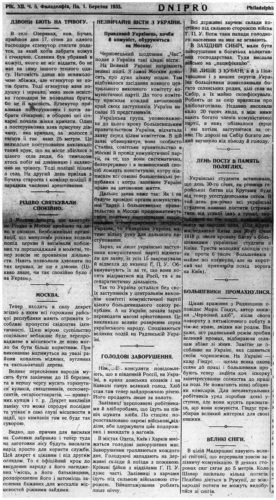
1933-03-01 : Page 1 : Column 1 : Article 3
“МОСКВА”
1933-03-01 : Page 1 : Column 2 : Article 1
“НЕЗВИЧАЙНІ ВІСТИ З УКРАЇНИ. Правдивий Українець, хочби й комуніст, обуруюється на Україну”
1933-03-01 : Page 1 : Column 2 : Article 2
“ГОЛОДОВІ ЗАВОРУШЕННЯ”
1933-03-01 : Page 1 : Column 3 : Article 3
“БОЛЬШЕВИКИ ПРОМАХНУЛИСЯ”
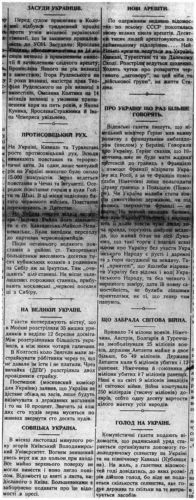
1933-05-01 : Page 1 : Column 2 : Article 2
“ПРОТИСОВІЦЬКИЙ РУХ”
1933-05-01 : Page 1 : Column 2 : Article 3
“НА ВЕЛИКІЙ УКРАЇНІ”
1933-05-01 : Page 1 : Column 3 : Article 1
“НОВІ АРЕШТИ”
1933-05-01 : Page 1 : Column 3 : Article 4
“ГОЛОД НА УКРАЇНІ”

1933-05-01 : Page 4 : Column 1: Article 2
"ДВАНАДЦЯТА ГОДИНА: ЧИ МИ ВЖЕ ГОТОВІ?"

1933-05-01 : Page 7 : Column 4: Article 2
"НЕСПОКІЙ СЕРЕД НАСЕЛЕННЯ"

1933-05-15 : Page 1 : Column 3 : Article 1
“ЗНИЩЕННЯ НЕПОКІРНОГО СЕЛА”
1933-05-15 : Page 1 : Column 3 : Article 3
"СЕЛЯНИ ВБИВАЮТЬ БЕЗБОЖНИКІВ"

1933-06-15 : Page 1 : Column 3 : Article 1
“КРІВАВІ РОЗРУХИ НА ВЕЛИКІЙ УКРАЇНІ”
1933-06-15 : Page 1 : Column 3 : Article 2
“ЗА ЗБРУЧЕМ І НАД ЗБРУЧЕМ”
1933-06-15 : Page 1 : Column 4 : Article 1
"КІНЕЦЬ УКРАЇНІЗАЦІЇ В УКРАЇНІ"

1933-06-15 : Page 7 : Column 4 : Article 2
"ЧИ СОВІТИ СПАСУТЬСЯ?"

1933-07-01 : Page 1 : Column 1 : Article 3
"БОЛЬШЕВИЦЬКА СТАТИСТИКА БРЕХЛИВА"
1933-07-01 : Page 1 : Column 3 : Article 1
"НЕ "СОВІТИ", А КОМУНІСТИЧНЕ САМОДЕРЖАВІЄ"
1933-07-01 : Page 1 : Column 4 : Article 1
"ЗБІЛЬШЕННЯ КОНТРОЛІ НАД КОЛХОЗАМИ"
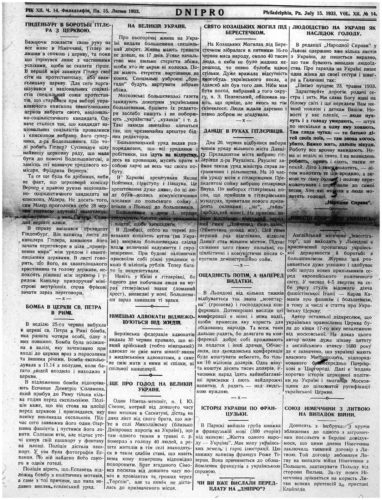
1933-07-15 : Page 1 : Column 2 : Article 1
“НА ВЕЛИКІЙ УКРАЇНІ”
1933-07-15 : Page 1 : Column 2 : Article 3
“ЩЕ ПРО ГОЛОД НА ВЕЛИКІЙ УКРАЇНІ”
1933-07-15 : Page 1 : Column 4 : Article 1
“ЛЮДОЇДСТВО НА УКРАЇНІ ЯК НАСЛІДОК ГОЛОДУ”

1933-08-15 : Page 6 : Column 4 : Article 1
""ТЯЖКО ЖИТИ НА ВКРАЇНІ": ЛИСТ З СОВІЦЬКОЇ УКРАЇНИ""

1933-09-01 : Page 1 : Column 1 : Article 1
"ДО КУЛЬТУРНОГО СВІТА. (В СПРАВІ ГОЛОДУ НА РАДЯНСЬКІЙ УКРАЇНІ)"
1933-09-01 : Page 1 : Column 2 : Article 2
"ВИКИНУЛИ АКАДЕМІКІВ І НАУКОВИХ РОБІТНИКІВ З ПАРТІЇ"
1933-09-01 : Page 1 : Column 3 : Article 1
“УКРАЇНСЬКЕ РОБІТНИЦТВО У ЛЬВОВІ ПРОТЕСТУЄ ПРОТИ ВИНИЩУВАННЯ МОСКВОЮ УКРАЇНИ”
1933-09-01 : Page 1 : Column 3 : Article 4
“СЕЛЯНСЬКА ВІДПОВІДЬ НА БЕЗБОЖНИЦЬКУ НАГІНКУ”
1933-09-01 : Page 1 : Column 4 : Article 2
“НА ПОМІЧ ГОЛОДУЮЧИМ”

1933-09-01 : Page 4 : Column 1 : Article 2
“БЕНКЕТ ПІДЧАС ЧУМИ”

1933-09-15 : Page 1 : Column 1- 4: Article 1
“ДО ВІРНИХ УКРАЇНСЬКОЇ ПРАВОСЛАВНОЇ ЦЕРКВИ В АМЕРИЦІ І КАНАДІ: АРХИПАСТИРСЬКЕ ПОСЛАННЯ АРХІЄПИСКОПА АМЕРИКАНСЬКОГО І КАНАДСЬКОГО ІОАННА ТЕОДОРОВИЧА”
1933-09-15 : Page 1 : Column 1 : Article 2
“ЗEЛЕНИЙ КЛИН В НУЖДІ”
1933-09-15 : Page 1 : Column 2 : Article 2
“НАЙБІЛЬШИЙ ГОЛОД НА УКРАЇНІ БУДЕ В ЗИМІ”
1933-09-15 : Page 1 : Column 4 : Article 2
"КОМІТЕТ НА ПОМІЧ ГОЛОДАЮЧІЙ УКРАЇНІ"

1933-09-15: Page 4 : Column 4 : Article 1
"В СПРАВІ ГОЛОДУ НА ВЕЛИКІЙ УКРАЇНІ"
1933-09-15: Page 4 : Column 4 : Article 2
"ІСПИТ НАЦІОНАЛЬНОЇ ЗРІЛОСТІ"

1933-10-01: Page 1 : Column 1 : Article 1
“МИ ЩЕ ПОКАЖЕМО, ЩО МИ КОЗАЦЬКОГО РОДУ”
1933-10-01 : Page 1 : Column 1 : Article 2
“КОЛЬОНІЗАЦІЯ УКРАЇНИ”
1933-10-01 : Page 1 : Column 4 : Article 1
“ПОМІЧ З РІДНОГО КРАЮ ГОЛОДНИМ БРАТАМ”
1933-10-01 : Page 1 : Column 4 : Article 2
“ВИДИРАЮТЬ ХЛІБ ВІД ГОЛОДНИХ”

1933-10-15 : Page 1 : Column 1 : Article 1
“КІНЕЦЬ ЗРАДНИКА”
1933-10-15 : Page 1 : Column 1 : Article 2
“НАША ЦЕРКВА НА ЛІНІЇ ПРОТЕСТУ ПРОТИ ГОЛОДУ”
1933-10-15 : Page 1 : Column 3 : Article 2
“БОЛЬШЕВИКИ НЕ ПУСКАЮТЬ НА УКРАЇНУ АНГЛІЙСЬКИХ ЖУРНАЛІСТІВ”
1933-10-15 : Page 1 : Column 4 : Article 1
“УКРАЇНСЬКІ КОМУНІСТИ КАЮТЬСЯ”
1933-10-15 : Page 1 : Column 4 : Article 2
“КОНҐРЕС НАЦІОНАЛЬНИХ МЕНШОСТЕЙ В БЕРНІ ЗАКЛИКАЄ ПРИЙТИ УКРАЇНІ НА ПОМІЧ"
1933-10-15 : Page 1 : Column 4 : Article 3
“ЖЕРТВИ ГОЛОДУ НА УКРАЇНІ”
1933-10-15 : Page 1 : Column 4 : Article 4
“ОТРУЮЮТЬ ЛЮДОЇДІВ”

1933-10-15 : Page 7 : Column 4 : Article 2
"НАЙСТРАШНІШИЙ З ПЛЯНІВ СРСР"
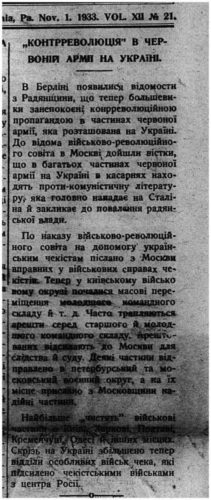
1933-11-01 : Page 1 : Column 4 : Article 1
“КОНТРРЕВОЛЮЦІЯ В ЧЕРВОНІЙ АРМІЇ НА УКРАЇНІ”

1933-11-01 : Page 6 : Column 2 : Article 1
"ДО УКРАЇНСЬКИХ ВИСТУПІВ У СПРАВІ ГОЛОДУ. ШЛЯХЕТИЙ ВИСТУП ГОЛОВИ РАДИ ЛІГІ НАЦІЙ В ОБОРОНІ УКРАЇНИ. Справа наша стала на годину центром світової уваги."

1933-11-01 : Page 7 : Column 3 : Article 2
"ВІСТІ З УКРАЇНИ"

1933-11-15 : Page 1 : Column 3 : Article 2
“ГОЛОД ЗАСОБОМ БОЛЬШЕВИЦЬКОЇ ПОЛІТИКИ”

1933-11-15 : Page 6 : Column 1-4 : Article 1
"ДОПИСИ. ГОЛОД НА УКРАЇНІ. (Зізнання втікачів з України і листи тих, хто втікати не змогли)"

1934-02-01 : Page 1 : Column 4 : Article 3
“КЛОПОТИ З КОМСОМОЛЬЦЯМИ НА УКРАЇНІ”
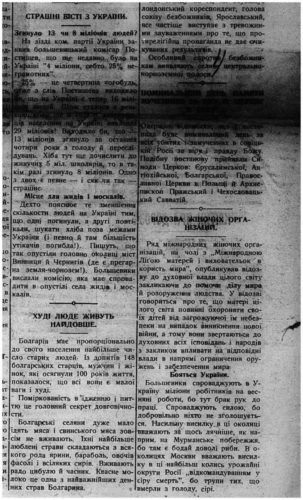
1934-05-15 : Page 1 : Column 3 : Article 2
“СТРАШНІ ВІСТІ З УКРАЇНИ”
1934-05-15 : Page 1 : Column 4 : Article 4
“БОЯТЬСЯ УКРАЇНИ”

1934-06-01 : Page 1 : Column 1: Article 2
“ПОСУХА В УКРАЇНІ Й КАВКАЗІ”
1934-06-01 : Page 1 : Column 4 : Article 1
“НОВА ГОЛОДОВА КАТАСТРОФА НА УКРАЇНІ”

1934-07-15 : Page 1 : Column 2 : Article 1
“ДАЛЬШЕ ВИНИЩУВАННЯ УКРАЇНЦІВ НА ПРИМУСОВИХ РОБОТАХ”
1934-07-15 : Page 1 : Column 2 : Article 2
“ВІСТІ ЗІ СХІДНОЇ УКРАЇНИ”

1934-11-15 : Page 1 : Column 2 : Article 1
“СОВІТИ ЗАБОРОНЯЮТЬ ПРИСИЛКУ ПОМОЧІ ГОЛОДАЮЧИМ”
1934-11-15 : Page 1 : Column 4 : Article 4
“ВІДБИРАЮТЬ ОСТАННЮ КОРОВУ”

1935-03-15 : Page 7: Column 1: Article 1
"З ЛИСТІВ З УКРАЇНИ"

1935-04-15 : Page 6: Column 4: Article 3
"НЕМА ГОЛОДУ В СРСР" (1 of 2)

1935-04-15 : Page 8: Column 2: Article 3
"НЕМА ГОЛОДУ В СРСР" (2 of 2)

1935-06-15 : Page 6 : Column 3-4: Article 1
""ВІРТЕ АБО НЕ ВІРТЕ, Я БАЧИВ ГОЛОД!" сказав Robert I. Ripley" (1 of 2)

1935-06-15 : Page 8 : Column 1 : Article 1
""ВІРТЕ АБО НЕ ВІРТЕ, Я БАЧИВ ГОЛОД!" сказав Robert I. Ripley" (2 of 2)

1935-07-15 : Page 1 : Column 3 : Article 2
“ВИНАРОДОВЛЕННЯ СОВІТСЬКОЇ УКРАЇНИ”

1935-09-01 : Page 1 : Column 1 : Article 3
“ПРОДАВАЛИ М’ЯСО ЛЮДЕЙ В ХАРКОВІ”
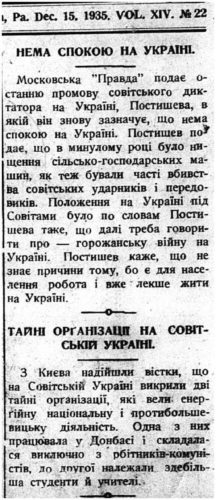
1935-12-15 : Page 1 : Column 4 : Article 1
“НЕМА СПОКОЮ НА УКРАЇНІ”
1935-12-15 : Page 1 : Column 4 : Article 2
“TАЙНІ ОРГАНІЗАЦІЇ НА СОВІТСЬКІЙ УКРАЇНІ”

1937-06-01 : Page 4 : Column 1-2 : Article 2
“СВОБОДА, РІВНІСТЬ, БРАТЕРСТВО І КОМУНІЗМ”

1938-06-15 : Page 3 : Column 2 : Article 2
“АНТИРЕЛІГІЙНА ПРОПАГАНДА І СІВБА В УССР”

1938-07-15 : Page 1 : Column 3 : Article 1
“КАТАСТРОФАЛЬНИЙ ЗАНЕПАД ХЛІБОРОБСТВА В УКРАЇНІ”
1938-07-15 : Page 1 : Column 3 : Article 5
“ВБИВАЮТЬ КОМУНІСТІВ В УКРАЇНІ”
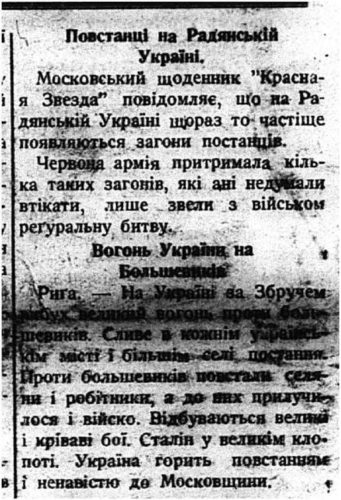
1938-09-15 : Page 1 : Column 4 : Article 2
“ПОВСТАНЦІ НА РАДЯНСЬКІЙ УКРАЇНІ”
1938-09-15 : Page 1 : Column 4 : Article 3
“ВОГОНЬ УКРАЇНИ НА БОЛЬШЕВИКІВ”

1940-04-15 : Page 3 : Column 1 : Article 2
“УКРАЇНСЬКА ЗЕМЛЯ ПІД СОВІТАМИ”

1940-05-15 : Page 3 : Column 2 : Article 2
“ЗАГРОЗА ГОЛОДУ НА УКРАЇНСЬКИХ ЗЕМЛЯХ”

1940-06-01 : Page 3 : Column 1 : Article 1
“В СОВІТСЬКІМ РАЮ”




